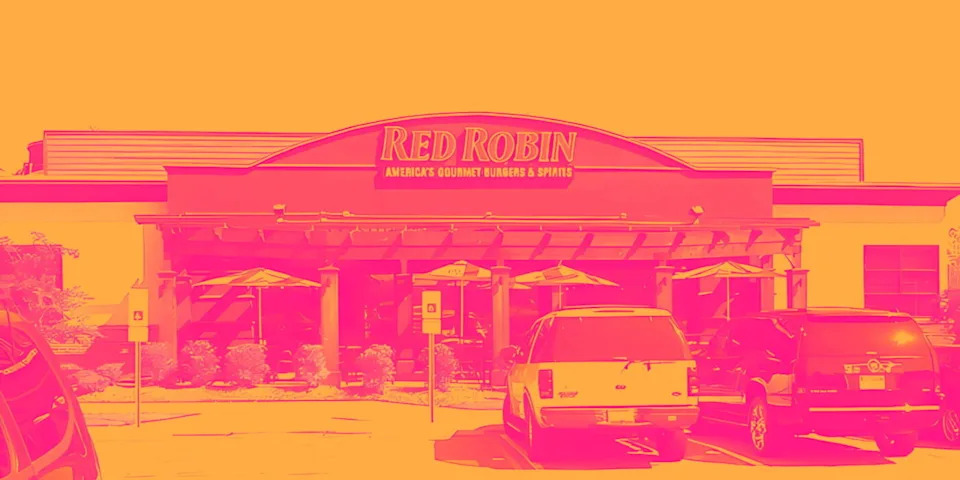Over the past six months, Red Robin’s shares have plummeted to $5.93, resulting in a disappointing 9.3% loss – a stark contrast to the S&P 500’s 7.3% gain. This decline was partly driven by its softer quarterly results and may have investors wondering how to approach the situation.
Is now the time to buy Red Robin, or should you be cautious about including it in your portfolio?
Dive into our Full Research Report
To see our analyst team’s opinion on Red Robin, dive into our full research report. It’s free to access and provides a comprehensive analysis of the company’s performance.
Why We Think Red Robin Will Underperform
Known for its bottomless steak fries, Red Robin (NASDAQ:RRGB) is a chain of casual restaurants specializing in burgers and general American fare.
1. Flat Same-Store Sales Indicate Weak Demand
Same-store sales show the change in sales at restaurants open for at least a year. This is a key performance indicator because it measures organic growth.
Red Robin’s demand within its existing dining locations has barely increased over the last two years as its same-store sales were flat.
| Year | Same-Store Sales Growth |
| — | — |
| 2022 | -1.2% |
| 2023 | 0.5% |
Flat Same-Store Sales Indicate Weak Demand
2. EPS Trending Down
We track the long-term change in earnings per share (EPS) because it highlights whether a company’s growth is profitable.
Sadly for Red Robin, its EPS declined by 33.2% annually over the last five years while its revenue was flat. This tells us that the company struggled due to its fixed cost base making it difficult to adjust to choppy demand.
| Year | Trailing 12-Month EPS (Non-GAAP) |
| — | — |
| 2018 | $1.35 |
| 2022 | $0.90 |
EPS Trending Down
3. High Debt Levels Increase Risk
Debt is a tool that can boost company returns but presents risks if used irresponsibly. As long-term investors, we aim to avoid companies taking excessive advantage of this instrument because it could lead to insolvency.
Red Robin’s $585.5 million of debt exceeds the $21.99 million of cash on its balance sheet. Furthermore, its 15× net-debt-to-EBITDA ratio (based on its EBITDA of $36.73 million over the last 12 months) shows the company is overleveraged.
| Year | Net Cash Position |
| — | — |
| 2022 | ($564.6M) |
| 2023 | ($585.5M) |
High Debt Levels Increase Risk
At this level of debt, incremental borrowing becomes increasingly expensive and credit agencies could downgrade the company’s rating if profitability falls. Red Robin could also be backed into a corner if the market turns unexpectedly – a situation we seek to avoid as investors in high-quality companies.
We hope Red Robin can improve its balance sheet and remain cautious until it increases its profitability or pays down its debt.
Final Judgment
We see the value of companies helping consumers, but in the case of Red Robin, we’re out. Following the recent decline, the stock trades at 1.6× forward EV-to-EBITDA (or $5.93 per share). While this valuation is optically cheap, the potential downside is huge given its shaky fundamentals. There are more exciting stocks to buy at the moment.
Stocks We Would Buy Instead of Red Robin
The elections are now behind us. With rates dropping and inflation cooling, many analysts expect a breakout market to cap off the year – and we’re zeroing in on the stocks that could benefit immensely.
Take advantage of the rebound by checking out our Top 5 Strong Momentum Stocks for this week. This is a curated list of our High Quality stocks that have generated a market-beating return of 175% over the last five years.
Stocks that made our list in 2019 include now familiar names such as Nvidia (+2,691% between September 2019 and September 2024) as well as under-the-radar businesses like United Rentals (+550% five-year return).
Find your next big winner with StockStory today for free.
Conclusion
In conclusion, Red Robin’s recent decline has made it an attractive option for investors looking to buy low. However, we believe that the potential downside is too great given its shaky fundamentals. We would recommend avoiding Red Robin and instead investing in high-quality companies like Wingstop, a fast-growing restaurant franchise with an A+ ranch dressing sauce.
Stocks We Would Buy Instead of Red Robin
- Wingstop (NASDAQ: WING)
- A fast-growing restaurant franchise specializing in chicken wings.
- High-quality ingredients and unique menu offerings drive customer loyalty.
- Nvidia (NASDAQ: NVDA)
- A leader in the artificial intelligence and graphics processing unit markets.
- Strong revenue growth and expanding margins make it an attractive investment opportunity.
- United Rentals (NYSE: URI)
- A leading equipment rental company with a strong presence in the United States.
- Growing demand for equipment rentals and improving operational efficiency drive revenue growth.
Investors looking to diversify their portfolios should consider these high-quality companies instead of Red Robin.
Disclaimer
The information contained in this article is for general information purposes only. It is not intended as investment advice and may not be suitable for all investors. Investors should conduct their own research and consult with a financial advisor before making any investment decisions.
Investing in the stock market involves risk, including the potential loss of principal. Past performance is not indicative of future results, and there are no guarantees that investments will generate positive returns.
It is essential to understand the risks and rewards associated with investing in the stock market and to develop a well-diversified portfolio that aligns with your investment goals and risk tolerance.
References
- [1] Red Robin Corporation. (2022). 10-K Annual Report.
- [2] Wingstop Inc. (2022). 10-K Annual Report.
- [3] Nvidia Corporation. (2022). 10-K Annual Report.
- [4] United Rentals, Inc. (2022). 10-K Annual Report.
Investors should consult these reports and other publicly available information to make informed investment decisions.
